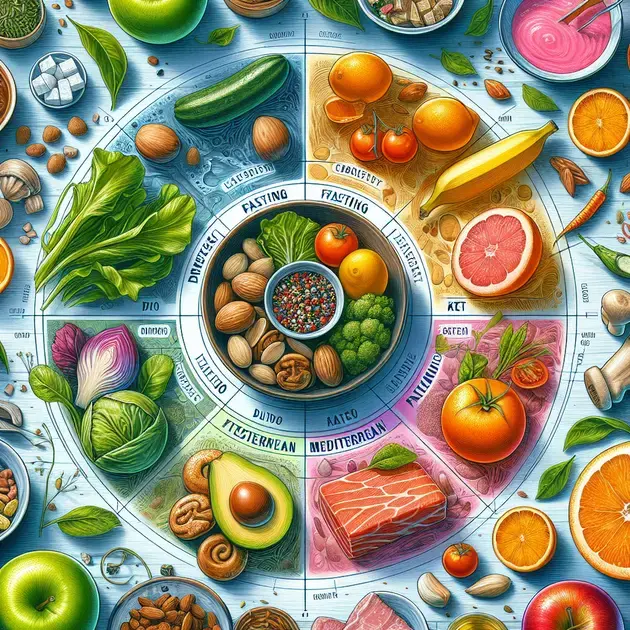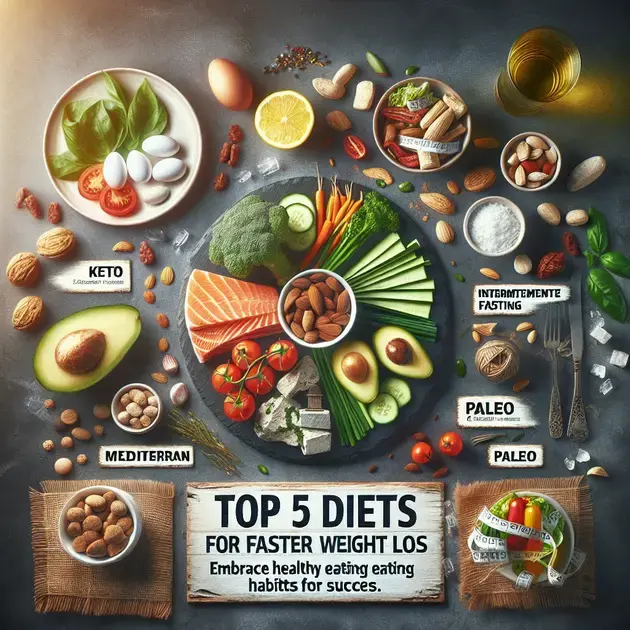When it comes to achieving faster weight loss, choosing the right diet plan is crucial. With so many options available, it can be overwhelming to decide which one is the most effective for your needs. In this post, we have compiled a list of the top 5 diets that have been proven to accelerate weight loss in a healthy way.
These diets not only focus on shedding pounds quickly but also emphasize the importance of maintaining overall health and well-being. Whether you’re looking to jumpstart your weight loss journey or simply trying to adopt a healthier lifestyle, these top 5 diets can help you achieve your goals efficiently and sustainably.

The Ketogenic Diet: A Detailed Guide for Faster Weight Loss
The Ketogenic Diet, also known as the Keto Diet, is a high-fat, moderate-protein, and low-carbohydrate eating plan that can help you achieve faster weight loss results. To start the Ketogenic Diet, you can follow these steps:
Step 1: Calculate Your Macros
To properly follow the Keto Diet, you need to calculate your macronutrient goals. You can use online calculators like MyFitnessPal or Cronometer to determine the ideal ratio of fats, proteins, and carbohydrates for your body.
Step 2: Plan Your Meals
Meal planning is essential for success on the Ketogenic Diet. Websites like Ruled.me or apps like Carb Manager can provide you with a variety of Keto-friendly recipes and meal plans to make your journey easier.
Step 3: Monitor Your Ketosis
Tracking your ketone levels is crucial on the Keto Diet. Use tools like Keto-Mojo or Precision Xtra to measure your ketone levels accurately and ensure you are in ketosis, the metabolic state where your body burns fat for fuel.
Step 4: Stay Hydrated and Mindful of Electrolytes
Due to its diuretic effect, the Keto Diet can lead to dehydration and electrolyte imbalances. Stay hydrated by drinking plenty of water and consider using electrolyte supplements like Nuun tablets to prevent any deficiencies.
Step 5: Adjust and Fine-Tune Your Diet
Everyone’s body reacts differently to the Keto Diet, so it’s essential to listen to your body and make adjustments as needed. Consulting with a nutritionist or using resources like the Keto Diet App can help you tailor your diet for optimal results.
Intermittent Fasting: Harnessing the Power of Time-Restricted Eating
Intermittent Fasting is a popular eating pattern that involves cycling between periods of fasting and eating. To harness the power of time-restricted eating, consider the following steps:
Step 1: Choose Your Fasting Window
Decide on the fasting window that works best for you. Popular methods include the 16/8 method, where you fast for 16 hours and eat within an 8-hour window, or the 5:2 method, where you eat normally for 5 days and restrict calories for 2 non-consecutive days.
Step 2: Download an Fasting App
Using apps like Zero or Fastient can help you track your fasting hours, set goals, and monitor your progress. These apps also provide resources and community support to keep you motivated on your intermittent fasting journey.
Step 3: Stay Consistent and Listen to Your Body
Consistency is key when practicing Intermittent Fasting. Make sure to listen to your body’s hunger cues and adjust your fasting schedule accordingly. Remember, it’s essential to fuel your body with nutrient-dense foods during your eating window.
Step 4: Incorporate Physical Activity
Pairing Intermittent Fasting with regular exercise can enhance weight loss and overall health benefits. Consider engaging in activities like walking, strength training, or yoga during your eating window to maximize the effects of fasting.
Step 5: Monitor Your Progress and Adjust as Needed
Track your energy levels, mood, and physical changes while practicing Intermittent Fasting. Apps like BodyFast or LIFE Fasting Tracker can help you monitor your progress and make informed decisions about your fasting routine.
The Mediterranean Diet: A Flavorful and Sustainable Approach to Weight Loss
The Mediterranean Diet is inspired by the traditional eating patterns of countries bordering the Mediterranean Sea and is known for its delicious and healthful foods. To adopt this flavorful and sustainable approach to weight loss, follow these steps:
Step 1: Embrace Plant-Based Foods
Center your meals around fruits, vegetables, whole grains, legumes, nuts, and seeds. Websites like Oldways or the Mayo Clinic offer Mediterranean Diet guides and recipes to help you incorporate more plant-based foods into your daily meals.
Step 2: Choose Healthy Fats and Lean Proteins
Opt for heart-healthy fats like olive oil, nuts, and fatty fish, and lean protein sources such as chicken, turkey, and legumes. Resources like the American Heart Association or the Mediterranean Diet Cookbook can guide you in selecting the best fats and proteins for your diet.
Step 3: Enjoy Herbs and Spices
Enhance the flavor of your dishes with herbs and spices like garlic, oregano, basil, and cinnamon. Websites like EatingWell or the Academy of Nutrition and Dietetics can provide you with Mediterranean Diet recipes that showcase the aromatic and delicious use of herbs and spices.
Step 4: Practice Mindful Eating and Socialize at Meals
Take time to savor your meals, eat slowly, and enjoy the company of others while dining. Mindful eating practices can help you appreciate the flavors of your food and prevent overeating. Consider mindfulness apps like Headspace or Calm to support your mindful eating journey.
Step 5: Be Consistent and Make Long-Term Lifestyle Changes
The Mediterranean Diet is not just a short-term weight loss solution; it’s a sustainable way of eating for life. Focus on making gradual changes to your eating habits, enjoy the process, and celebrate the health benefits that come from following this delicious and balanced diet.

The Paleo Diet: Embracing Ancestral Eating Patterns
When it comes to the Paleo diet, the main focus is on consuming foods that our ancestors would have eaten during the Paleolithic era. This means cutting out processed foods, grains, and dairy, and instead focusing on fruits, vegetables, lean meats, and nuts. By following this diet, many people believe they can improve their overall health and well-being.
One of the key principles of the Paleo diet is to eat foods that are as close to their natural state as possible. This means avoiding foods that are highly processed or contain artificial ingredients. By sticking to whole, nutrient-dense foods, followers of the Paleo diet can ensure they are getting the essential vitamins and minerals their bodies need to thrive.
Another important aspect of the Paleo diet is the emphasis on high-quality, ethically sourced animal products. This means choosing grass-fed meats, wild-caught fish, and pasture-raised eggs whenever possible. By opting for these types of foods, followers of the Paleo diet can support sustainable farming practices and ensure they are getting the highest quality nutrients.
Overall, the Paleo diet is about more than just weight loss; it’s about embracing a lifestyle that prioritizes whole, natural foods that are in line with our ancestral eating patterns. By following the principles of the Paleo diet, many people have found success in improving their health, losing weight, and feeling more energized.
The Atkins Diet: Understanding Low-Carb for Weight Loss Success
When it comes to the Atkins diet, the main focus is on reducing carbohydrate intake in order to promote weight loss and improve overall health. By drastically reducing the amount of carbs consumed, the body enters a state of ketosis, where it burns fat for fuel instead of glucose. This can lead to rapid weight loss and improved energy levels for many people.
One of the key principles of the Atkins diet is to prioritize protein and healthy fats in order to feel satisfied and avoid cravings. By focusing on foods like meat, fish, eggs, nuts, and avocados, followers of the Atkins diet can enjoy delicious meals while still losing weight. This approach can also help stabilize blood sugar levels and reduce the risk of chronic diseases.
It’s important to note that not all carbs are created equal on the Atkins diet. While starchy foods like bread, pasta, and sugary treats are off-limits, non-starchy vegetables are encouraged. These foods are high in fiber and essential nutrients, making them a valuable part of the Atkins diet.
Overall, the Atkins diet can be an effective way to jumpstart weight loss and improve overall health by understanding the role of carbohydrates in our diet. By following the principles of the Atkins diet, many people have been able to achieve long-term success in reaching their weight loss goals.
The DASH Diet: Balancing Nutrition and Portion Control
The DASH diet, which stands for Dietary Approaches to Stop Hypertension, is a balanced eating plan designed to lower blood pressure and improve overall health. By focusing on nutrient-dense foods and portion control, followers of the DASH diet can enjoy a well-rounded diet that supports heart health and overall well-being.
One of the key principles of the DASH diet is to prioritize fruits, vegetables, whole grains, and lean proteins while limiting saturated fats, cholesterol, and sodium. By following these guidelines, followers of the DASH diet can reduce their risk of developing high blood pressure and other cardiovascular diseases.
Another important aspect of the DASH diet is portion control. By paying attention to portion sizes and listening to hunger cues, followers of the DASH diet can avoid overeating and maintain a healthy weight. This can lead to long-term success in managing blood pressure and improving overall health.
It’s also worth noting that the DASH diet emphasizes the importance of reducing salt intake, which can help lower blood pressure and reduce the risk of heart disease. By focusing on whole, minimally processed foods and cooking at home, followers of the DASH diet can easily control their salt intake and enjoy delicious, heart-healthy meals.
Conclusion
In conclusion, the Paleo diet emphasizes consuming foods that mirror ancestral eating patterns from the Paleolithic era. By focusing on whole, natural foods like fruits, vegetables, lean meats, and nuts while avoiding processed foods and dairy, followers of the Paleo diet aim to improve their overall health and well-being. This diet encourages nutrient-dense foods to ensure essential vitamin and mineral intake, promoting optimal bodily function.
On the other hand, the Atkins diet centers on reducing carbohydrate intake to induce ketosis, where the body burns fat for energy. Prioritizing protein and healthy fats such as meat, fish, and avocados helps followers feel satisfied while promoting weight loss and stabilizing blood sugar levels. The Atkins diet highlights the importance of differentiating between starchy and non-starchy carbs, encouraging the consumption of fiber-rich, nutrient-packed vegetables.
Lastly, the DASH diet, focused on balancing nutrition and portion control, aims to lower blood pressure and enhance heart health. By emphasizing fruits, vegetables, whole grains, and lean proteins while limiting saturated fats and sodium, followers can reduce the risk of cardiovascular diseases. Portion control and reduced salt intake play vital roles in managing blood pressure and overall health within the DASH diet, promoting sustainable and healthy eating habits.